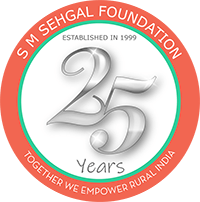By Daksh Kalra
My own perception of financial literacy was almost a taken-forgranted one, as I always found it to be a quite intuitive and accessible at least as far as basic banking and insurance concepts were concerned. I used the word “was” to specifically point out how my perception completely changed when I was given the opportunity to be a part of the team of Project Samarth—a financial literacy camp in district Nuh, Haryana, as a volunteer for S M Sehgal Foundation. The camp was jointly set up in collaboration with Canara HSBC OBC Life Insurance Co. Ltd. to bridge the awareness gap on financial literacy in the district, leading to financial inclusion by broadcasting informative shows on community radio Alfaz-e-Mewat, an initiative of the foundation. The camp began at around 10:30 a.m. on an unusually warm winter morning. Quite opposite to my expectations, close to 400 people turned up only on the basis of hearing some radio announcements. Amazing!
Informative lectures, a street play on the importance of financial literacy, and special counters to help people initiate the accountopening process, were the important highlights of the camp. Although I was pleased to see the general enthusiasm among the people, specifically among the female and adult male strata, there were many who were completely disinterested in the process, suggesting a dire need for a change in awareness among the people.
Seeing many people struggling with the form, I decided to help with filling out the forms. Seeing a family of six, who had come fully prepared with their ID proofs, photocopies, and passport photographs, etc., to open their bank accounts wanting to seek help in filling the forms made me realize two things: first, there is the high illiteracy rate in the village, and second, there is a need to simplify the account-opening process through a joint effort by the banks and the government. While I was helping to fill out their forms, I asked a question that looked at first like an ordinary question on the form, but it led to a change in the facial expression and behavior of the head of the family as if he were greatly insulted. The question was regarding their annual income. As I listed out the options mentioned in the form namely: “less than Rs. 200,000 per annum,” “200,000–500,000 per annum,” etc., I was told that 200,000 was such a huge amount of money, and they had never seen such an amount in their life. Small and marginal farmers in rural India earn barely enough to serve the basic needs of the family, sometimes even less. This again made me realize the importance and value of money.
Without aggravating the matter further, and with a sense of guilt, I moved on to other questions. Another strange thing I noticed while going through the identity proofs was the birthdates on the Aadhaar cards. Every third person had 1st Jan followed by the closest approximation of their birth years.
One response that made me particularly happy was their answer regarding their wives’ occupations, to which they proudly replied that their wives worked with them as equal partners and were not just confined to the work of the house.
My experience helping out at the camp made me introspective about a few things: first, contrary to my views about ignorance being the biggest barrier in the path toward financial literacy, I realized that the accessibility to the appropriate resources as well as proper guidance to use these resources plays an equally important role; second, the part played by the local community leaders in spreading awareness is crucial to the successful achievement of objectives in a social setting; and perhaps most important, a small step in the right direction can leave a big imprint of hope and prosperity in the minds of people.
(Daksh Kalra volunteered with the Communications team at S M Sehgal Foundation from December 20, 2017-January 5, 2018)


